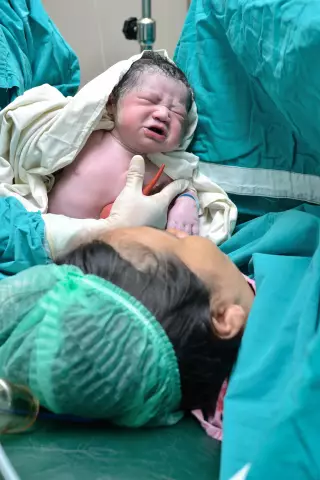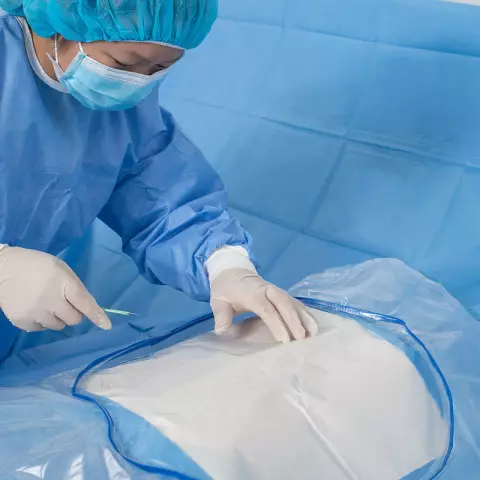- Author Rachel Wainwright [email protected].
- Public 2023-12-15 07:39.
- Last modified 2025-11-02 20:14.
Emergency caesarean section

Not many people realize that such a method of giving birth as a cesarean section was known back in the Antiquity. The first mention of a caesarean section in the history of mankind can be considered the ancient Greek myth of Dionysus, who, according to legend, was removed from the womb of a deceased mother and thus saved from certain death.
Roman doctors also performed caesarean sections to save the child's life when the mother died in childbirth. Only in the 17th century did doctors begin to operate on living women, trying to save not only the child, but also the mother. However, in the vast majority of cases, women in labor died both during and after the operation. The situation changed radically with the beginning of the “era of antibiotics” in the last century.
Already in the middle of the 20th century, doctors were able to improve the process of performing a caesarean section, which contributed to a significant reduction in the mortality of women in childbirth. Although modern doctors do not see anything extraordinary in caesarean section, many expectant mothers still fear the outcome of childbirth.
Emergency caesarean section
Medical statistics claim that cesarean section is the most popular abdominal surgery among women. Even during pregnancy, a gynecologist at the antenatal clinic can identify indications for an operation. In this case, the expectant mother is prescribed a planned cesarean section. Each woman decides for herself where to perform the operation, but in any case, before the cesarean section, the expectant mother should undergo a medical examination.
Often, maternity ward doctors are faced with situations when already in the process of childbirth they have to resort to the help of an emergency caesarean section. As a rule, the need for urgent surgical intervention and a caesarean section arises in cases where childbirth cannot be resolved naturally without prejudice to the life or health of the mother and child.
Unlike a planned caesarean section, indications for emergency surgery may arise directly during childbirth. It also happens that a woman begins to give birth naturally, but after a while it becomes clear to doctors that without a cesarean section, the child will not be able to be born.
In fact, the main difference between an emergency cesarean section and a planned operation can be considered the fact that doctors use this type of surgical intervention directly during childbirth in the presence of complications that threaten the life and health of the woman in labor, as well as the fetus. Moreover, indications for an emergency caesarean section can be problems not only with the health of the mother, but also the child.
Indications for emergency caesarean section
Indications for emergency surgery may arise on the part of a woman in labor, for example, due to complications against the background of existing diseases and abnormalities. Problems can arise with the child's health. So, why is a caesarean section done during a natural birth:
- Immediate surgical intervention is indicated when, during childbirth, the doctor finds out that the internal dimensions of the woman's pelvis do not correspond to the size of the fetus at all. Even during normal labor, when the contractions are in full swing and the uterus has already opened, the baby's head may not move along the birth canal. This happens when the woman in labor has anatomical abnormalities that could not be determined before delivery, as well as when the fetus is large. To such a situation, the term “clinically narrow pelvis” is used;
- An emergency cesarean section is performed with premature rupture of amniotic fluid, when there is no effect of drug stimulation of labor. After the discharge of amniotic fluid, the fetus simply cannot remain in the uterus without protection from infections, so there is a need for immediate surgery;
- Operation cannot be avoided when abnormalities in the development of labor are detected. Modern doctors almost always stimulate labor with medications. It so happens that even under the influence of medications, contractions in a woman in labor are weak and short-lived. This happens all the time, as it is caused by some factors, for example, excessive nervous tension or malformation of the uterus;
- Disruption of the connection between the uterine wall and the placenta may become an indication for an emergency caesarean section. Placental abruption during natural childbirth can harm both the woman in labor and the fetus, since it is accompanied by the occurrence of bleeding;
- An emergency caesarean section is also done due to a ruptured uterus, although this birth injury is extremely rare. With a rupture of the uterus, as with placental abruption, serious bleeding opens;
- An emergency caesarean section is performed with acute fetal hypoxia, as well as in the case of prolapse or presentation of the umbilical cord loops. It so happens that due to the non-standard location of the fetus, the umbilical cord loops, located too close to the walls of the pelvis, are blocked by the fetal head. In this case, the umbilical cord loops are said to be in front of the baby's head.
The operation is done when a pathology occurs, for example, with gestosis. This disease most often develops against the background of impaired renal function during the second half of pregnancy and is expressed in an increase in blood pressure, in convulsions, as well as in an increase in the protein content in the urine

The above are just the main reasons why a cesarean section is performed during a vaginal delivery. However, other indications for emergency surgery may arise during childbirth. Neither the doctor nor the woman in labor herself can predict in advance how the birth will end.
Undoubtedly, in the medical practice of every obstetrician-gynecologist there are cases when, at first glance, successful natural childbirth ended with an emergency caesarean section. There is an opinion that it is better to give birth in a paid clinic. Of course, there is no point in comparing the conditions of an average maternity hospital with a paid medical institution.
However, it is worth noting that no matter where the caesarean section is performed - in a regular maternity hospital or in an elite foreign clinic, unplanned complications may occur during the operation. In this case, a much more important role will be played not by a spacious single room, a comfortable environment and polite staff, but by the professionalism of the doctor and his ability to make the right decisions in emergency situations.
Found a mistake in the text? Select it and press Ctrl + Enter.






